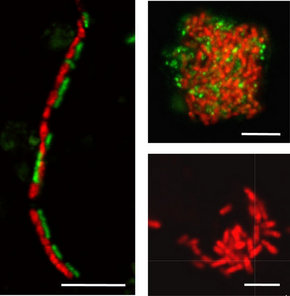Research Projects
Selected recent projects
Field work areas / Participation in expeditions
| 2016 | RV Atlantis cruise AT37-06 with submersible ALVIN; Hydrothermal vents of the Guaymas Basin, Gulf of California |
| Polarstern cruise PS101, Karasik Seamount, Gakkel Ridge, Arctic: Aim: Biogeochemistry of the vent plume | |
| 2015 | RV Meteor cruise 114; Methane and heavy oil seepage in the Campeche hydrocarbon province, Gulf of Mexico; Aim: Diversity and microbiology of hydrocarbon-degrading microorganisms |
| 2014 | RV Polarstern cruise 86 (ARKXXVIII); Aurora Vent Field, Gakkel Ridge, Arctic, biogeochemistry of vent systems associated with ultra-slow spreading ridges. Aim: Vent-associated microbial activity in the water column |
| 2009 | RV Atlantis cruise AT15-45 with submersible ALVIN; Hydrothermal Vents of the Guaymas Basin, Gulf of California; Aim: Anaerobic oxidation of methane under thermophilic conditions |
| Himmersfjärden, Baltic Sea; Carbon dynamics in Baltic Sea fjord sediments; Aim: Application of dual stable isotope probing | |
| RV Sonne cruise 191; Cold seeps of the Hikurangi margin, New Zealand (new vents project) | |
| 2006 | RV Meteor cruise M67-2b; Chapopote asphalt volcano, Campeche hydrocarbon province, Gulf of Mexico |
| 2005 | RV Alkor cruise 267; North Sea (Norwegen Shelf), EXOCET |
| RV Heincke cruise 208; Gullfaks, Tommeliten, North Sea |
Microbial life at hydrothermal vents of the Guaymas Basin, Gulf of California
My main goals here are (I) the quantification of microbial processes such as methanotrophy, methanogenesis and sulfate reduction under present temperatures, (II) the identification of microorganisms involved in these processes and (III) lipid formation in the different temperature regimes.

Microbial alkane degradation at asphalt volcanoes
Dual stable isotope probing in subsurface sediments
Molecular methods revealed that the deep subsurface hosts a large microbial diversity and harbors up to 1/3 of all microbial cells on earth. However, the basis of metabolic activity and energetics of most of these microorganisms are only poorly understood. We applied dual stable isotope probing with deuterated water (D2O) and 13C-labeled bicarbonate (13CDIC). Assessment of D and 13C assimilation into microbial membrane lipids allows the quantification of total lipid production and inorganic carbon assimilation rates without addition of artificial energy sources. Furthermore we can determine the role of heterotrophic and autotrophic carbon fixation in the sediment. For our first study site, the Swedish bay “Himmersfjarden” we were able to demonstrate predominantly heterotrophic carbon fixation. Furthermore, we demonstrated that in these young sediments bacteria are much more active than archaea. The results of this and ongoing studies aim a further understanding of the role of archaea and bacteria in their particular environment. Recent dual-SIP projects include carbon fixation in vent systems and deep-sea sediments.
In a second dual-SIP project we studied microbial carbon fixation in hydrothermal sediments from the Guaymas Basin. We found that the methane-oxidizing archaea (ANME) and their partner bacteria are complete autotrophs, meaning they use methane only as energy source but fix their carbon completely from inorganic carbon. The chemoorganoautotrophic nature of ANME archaea has to be kept in mind when interpreting natural carbon isotopic signatures.
Characterizing the interaction of microorganisms mediating the anaerobic oxidation of methane
From Guaymas sediments, we successfully enriched anaerobic methanotrophs that perform anaerobic oxidation of methane at elevated temperatures up to 70°C. The enriched thermophilic communites are dominated by distinct groups of ANME-1 and HotSeep-1 partner bacteria (Holler et al., 2011). By combining physiological experiments, electron microscopy, and genomics we identified direct interspecies electron transfer mediated by nanowire-like connections as driver for the interaction of ANME-1 archaea and their partner bacteria. Currently, we test our model on different related microbial associations.
